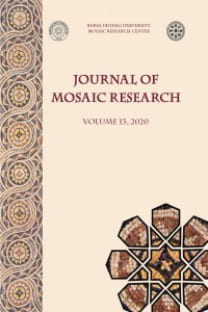Faenza’daki Geç Antik Çağ Via Dogana Domusu: Vestibulum Mozaiği. Restorasyon İşleminin Tamamlanması, Yeni Koruma ve İyileştirme Metodları
Bu makale, İS 5. yüzyıla ait önemli bir taban mozaiği üzerinde yürütülen multidisipliner çalışmayı ve restorasyon çalışmasının tamamlanmasını anlatmaktadır. Faenza şehir merkezinde 1970 lerde keşfedilen renkli ve figürlü büyük bir mozaik zemin Geç Antik Çağ’a ait bir domusun vestibulum bölümüne aitti.
Parco Archeologico di Classe - RavennAntica Vakfı ile Bologna Üniversitesi Koruma ve Restorasyon Yüksek Lisans Programı arasındaki etkili bir işbirliği mozaik restorasyonu ve iyileştirmesi ile ilgili bazı metodolojilerin denenmesine, test edilmesine geliştirilmesine olanak sağlamıştır.
Mozaik üzerindeki küçük boşlukların tamamlanması için özellikle kireç harç kullanımına ilişkin deneysel çalışmalar yapılmıştır. Ayrıca, zeminin tümünün üç boyutlu rölyefine ek olarak bazı sanal birleştirme önerileri de oluşturulmuştur. Aynı zamanda müze projesine dahil edilmek üzere bazı bilgi panelleride önerilmiştir.
Restorasyon, bu haliyle böylesine önemli bir sanatsal tanıklığın geliştirilmesini ihmal etmeyen bir çalışma ve aktif deney anı olmuştur
Anahtar Kelimeler:
Mozaik, Geç Antik, domus, vestibulum, restorasyon, koruma
Late Antique Domus of Via Dogana in Faenza: The Vestibulum Mosaic. Completion of the Restoration Work, New Methods for Conservation and Enhancement
This paper describes the multidisciplinary study and the completion of the restoration work conducted on an important floor mosaic from the fifth century AD. The floor, a big polychrome and figured mosaic, was discovered in the 1970s in the city center of Faenza and belonged to the vestibulum of a late antique domus.
An effective collaboration between the Parco Archeologico di Classe - RavennAntica Foundation and the University of Bologna Master Degree in Conservation and Restoration has allowed to experiment, test, and improve some methodologies concerning mosaic restoration and enhancement.
Specifically, some experimental studies regarding the use of lime mortars were carried out, in order to reintegrate the small gaps in the mosaic. Furthermore, in addition to a three-dimensional relief of the whole floor, some virtual integration proposals were created. At the same time, some information panels were proposed to integrate the museum project.
The restoration was thus a moment of study and active experimentation, that did not neglect the enhancement of such a significant artistic testimony.
Keywords:
Mosaic, Late Antique, domus, vestibulum, restoration, conservation,
___
- Dunbabin 2018 K. M. D. Dunbabin, “The Transformations of Achilles on Late Roman Mosaics in the East”, L. Audley-Miller - B. Dignas (eds.), Wandering Myths, Transcultural Uses of Myth in the Ancient World, 357-395.
- Fabbri et al. 2013 B. Fabbri - S. Gualtieri - C. Leonardi, “Modifications inducted by the thermal treatment of kaolin and determination of reactivity of metakaolin”, Applied Clay Science 73, 2-10.
- Farneti 1993 M. Farneti, Glossario tecnico-storico del mosaico, Con una breve storia del mosaico, Ravenna.
- Franzoni 2020 A. Franzoni, Domus tardoantica di via Dogana a Faenza. Il mosaico del vestibulum, Studio e restauro di tre lacerti. Metodologia e sperimentazione per la scelta delle malte da integrazione, Unpublished Master‘s degree Thesis, Alma Mater Studiorum Università di Bologna, Ravenna.
- Gameiro et al. 2012 A. Gameiro - A. Santos Silva - R. Veiga - A. Velosa, “Hydratation product of lime-metakaolin pastes at ambient temperature with ageing”, Thermochimica Acta 535, 36-41.
- Gentili 1980 G. V. Gentili, “Mosaici augustei e tardo romani scoperti negli ultimi anni a Faenza. I mosaici dell’edificio tardoromano di via Dogana”, V. Righini Cantelli (ed.) Un museo archeologico per Faenza: repertorio e progetto, Bologna, 421-487.
- Gizzi 2015 S. Gizzi, “Può esistere un restauro non sostenibile?”, G. Biscontin (ed.) Scienza e Beni Culturali. Quale sostenibilità per il restauro? Atti del convegno di studi (Bressanone, 1-4 luglio 2014), Venezia, 23-27.
- Grilo et al. 2014 J. Grilo - A. Santos Silva - P. Faria - A. Gameiro - R. Veiga - A. Velosa, “Mechanical and mineralogical properties of natural hydraulic lime-metakaolin mortars in different curing conditions”, Construction and Building Materials 51, 287-294.
- Macchiarola 2015 M. Macchiarola, “Mosaico. Malte da restauro e normativa”, C. Angelelli - A. Paribeni (ed.) Atti del XX Colloquio AISCOM, Ravenna, 699-702.
- Maioli 1987 M. G. Maioli, “L’edilizia privata tardoantica in Romagna: appunti sulla pavimentazione musiva”, Corso di cultura sull’arte ravennate e bizantina 34, 209-251.
- Maioli 1995 M. G. Maioli, “Il complesso di via Dogana e altri mosaici tardo antichi in Faenza”, R. Ling (ed.), Fifth International Colloquium on Ancient Mosaics, Milano, 189-206.
- Mandara 2018 A. Mandara, L’idea di allestimento, in RavennAntica, Periodico di RavennAntica, 1, Classe, 8.
- Mandara 2021 A. Mandara, L’idea di allestimento. Pregare e abitare a Ravenna, Exposition project relation, Ravenna.
- Menghi 2017 R. Menghi, “Realtà virtuale e bei culturali”, D. Biagi Maino - G. Maino (eds.), Principi e applicazioni del restauro virtuale, Firenze, 41-45.
- Monti 2017 M. Monti, “Principi e tecniche del restauro virtuale”, D. Biagi Maino - G. Maino (eds.), Principi e applicazioni del restauro virtuale, Firenze, 35-41.
- Mosca et al. 2010 C. Mosca - A. Jornet - G. Cavallo, “Confronto tra intonaci tradizionali e premiscelati: un’occasione per riflettere”, Arkos, Scienza e Restauro, Forum italiano calce 20, 73-77.
- Sagripanti 2021 E. Sagripanti, Domus tardoantica di via Dogana a Faenza. Il mosaico del vestibulum. Completamento del restauro, Metodologie del restauro virtuale finalizzate alla musealizzazione, Unpublished Master‘s degree Thesis, Alma Mater Studiorum Università di Bologna, Ravenna.
- ISSN: 1309-047X
- Başlangıç: 2008
- Yayıncı: Ululdağ Üniversitesi, Mozaik Araştırlmaları Merkezi
Sayıdaki Diğer Makaleler
Nil Nehri’nin Mozaiklerdeki Temsili: Çeşitli Bağlamlar, Çeşitli Anlamlar
Mozaik Araştırmalarında Kullanılan Arkeometrik Yöntemler ve Örnekleri
Hierapolis (Pamukkale) Saint Philip Kilisesi Mozaik Harcının Analizi ve Konservasyonu
Doğu Mozaiklerinde Yarı İnsan Yarı Bitkisel Melezler
Rhodiapolis Piskoposluk Kilisesi Mozaikleri
Mozaikte Tamamlama: Uygulama Biçimleri ve Koruma Bakış Açısıyla Değerlendirmeler
Matematik Teoremlerinin Antik Dönem Mozaikleri Üzerinde Tespiti
Agnese FRANZONI, Elena SAGRIPANTI, Paola PERPIGNANI, Michele MACCHIAROLA, Simone ZAMBRUNO
